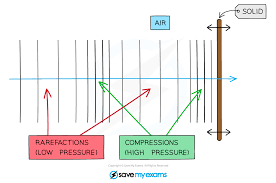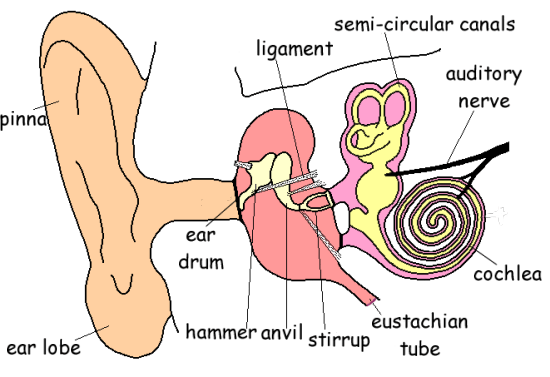
Sound Waves
Sound travels as a wave
Sound waves are caused by vibrating objects. These vibrations are passed through the surrounding medium as a series of compressions and rarefactions
Sound generally travels faster in solids it does so by causing the particles in the solid to vibrate
When a sound wave travels through a solid it does so by causing the particles in the solid to vibrate
Sound can’t travel in space, because it’s mostly a vacuum
Sometimes the sound waves will eventually travel into someone’s ear and reach their ear drum at which point they might hear the sound

You hear sound when your ear drum vibrates
Sound waves that reach your ear drum can cause it to vibrate
These vibrations are passed on to tiny bones in your ear called ossicles, through the semicircular canals and to the cochlea
The cochlea turns these vibrations into electrical signals which get sent to your brain and allow you to sense the sound
Different materials can convert different frequencies of sound waves into vibrations. For example, humans can hear sound in the range of 20Hz-20kHz.Microphones can pick up sound waves outside of this range, but if you tried to listen to this sound, you probably wouldn’t hear anything
Human hearing is limited by the size and shape of our ear drum, as well as the structure of all parts within the ear that vibrate to transfer the energy from the sound waves

Sound waves can reflect and refract
Sound waves will be reflected by hard flat surfaces. Echoes are just reflected sound waves.
Sound waves will also refract as they enter different media. As they enter denser material, they speed up. This is because when a wave travels into a different medium, its wavelength changes but its frequency remains the same so its speed must also change
Sound Waves
Sound travels as a wave
Sound waves are caused by vibrating objects. These vibrations are passed through the surrounding medium as a series of compressions and rarefactions
Sound generally travels faster in solids it does so by causing the particles in the solid to vibrate
When a sound wave travels through a solid it does so by causing the particles in the solid to vibrate
Sound can’t travel in space, because it’s mostly a vacuum
Sometimes the sound waves will eventually travel into someone’s ear and reach their ear drum at which point they might hear the sound

You hear sound when your ear drum vibrates
Sound waves that reach your ear drum can cause it to vibrate
These vibrations are passed on to tiny bones in your ear called ossicles, through the semicircular canals and to the cochlea
The cochlea turns these vibrations into electrical signals which get sent to your brain and allow you to sense the sound
Different materials can convert different frequencies of sound waves into vibrations. For example, humans can hear sound in the range of 20Hz-20kHz.Microphones can pick up sound waves outside of this range, but if you tried to listen to this sound, you probably wouldn’t hear anything
Human hearing is limited by the size and shape of our ear drum, as well as the structure of all parts within the ear that vibrate to transfer the energy from the sound waves

Sound waves can reflect and refract
Sound waves will be reflected by hard flat surfaces. Echoes are just reflected sound waves.
Sound waves will also refract as they enter different media. As they enter denser material, they speed up. This is because when a wave travels into a different medium, its wavelength changes but its frequency remains the same so its speed must also change
 Knowt
Knowt
